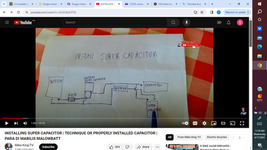Spiffdandy
Newbie level 4

I am looking to add a small bank of super capacitors to my Etrike, not to provide power, but to be charged from the batteries to give a power boost when needed. It is a 60V - 1000 W motor. I need to put a diode between the controller and the motor to prevent backflow of capacitor surge in to the controller.
So Im needing:

Selection of capacitors ( voltage 80w? 100w?) *looking for 3-10 seconds discharge time at the desired voltage
Selection of Diode ( and any installation hints I might need to know)
Look at the diagram, anything else that I might need to include or change.
Thanks in advance
So Im needing:
Selection of capacitors ( voltage 80w? 100w?) *looking for 3-10 seconds discharge time at the desired voltage
Selection of Diode ( and any installation hints I might need to know)
Look at the diagram, anything else that I might need to include or change.
Thanks in advance


